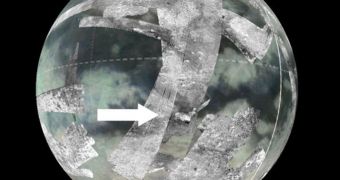The largest moon around Saturn is renowned for the fact that its polar regions contain many liquid hydrocarbon lakes. But astronomers were recently able to determine that the object also features at least one ice volcano.
According to the team that conducted the investigation, the contents of the volcano's ejecta cone are not yet known. It may be that it spews out hydrocarbons, or maybe even water-ice vapor or organic molecules, such as the tiger stripe-like features of the moon Enceladus.
But it could be that the volcano produces a whole other array of materials entirely. The formation may in fact be contributing to the haziness of the moon's atmosphere, which is notoriously thick.
The new discovery carries a lot of meaning, experts say, referring to the fact that the very existence of the volcano provides a deeper understanding of the carbon cycle on the object.
But the most important implication is that life may exist on Titan after all. The existence of the volcano significantly increases the chances that organic molecules can develop into life's precursors there.
“We finally have some proof that Titan is an active world,” said on December 14 US Geological Survey (USGS) expert geophysicist and study co-author, Randy Kirk.
The scientist was speaking to reporters at the 2010 annual fall meeting of the American Geophysical Union (AGU), Space reports. He said that the moon may be harboring an ice volcano called a cryovolcano, of the type that exists on Enceladus as well.
Existing theories about this type of structures hold that they can develop on numerous space bodies, and especially on frigid moons around gas giants such as Jupiter and Saturn.
Enceladus' was first to be discovered, and Titan's could be the second. The object was detected using the Visual and Infrared Mapping Spectrometer (VIMS) instrument aboard the NASA Cassini orbiter, alongside radar measurements.
Observations were concentrated around a landscape feature called Sotra Facula, which features three large conical features. In the new images, material can clearly be seen flowing outwards from these three points of interest.
There are also several deep pits at the location. According to measurements, the peaks are between 3,280 and 4,921 feet (1,000 to 1,500 kilometers) tall, while the deepest pit reaches 4,921 feet (1,500 meters) underground.
Experts say that these structures point directly at the existence of a cryovolcano. “It's really this combination of features that makes us think we've found good evidence of a volcano on Titan,” Kirk says.
“Titan is an extremely sparsely cratered world. Cryovolcanism is by far the best explanation, in my view,” explains University of Arizona expert Jeffrey Kargel, who was not a part of the research.
“The cryovolcano offers a perfect opportunity to get that methane gas from the interior of Titan into the atmosphere,” concludes NASA Jet Propulsion Laboratory (JPL) Cassini project scientist Linda Spilker.

 14 DAY TRIAL //
14 DAY TRIAL //